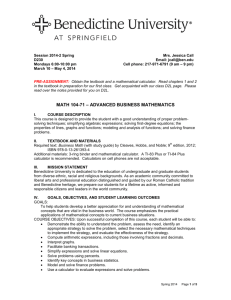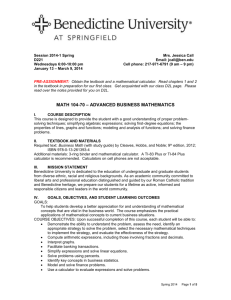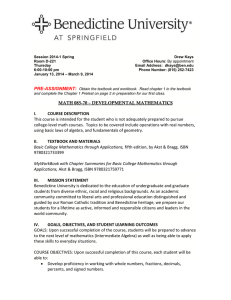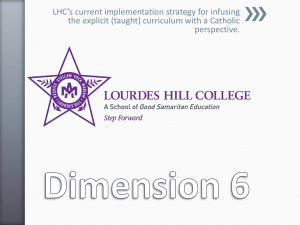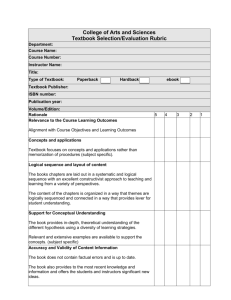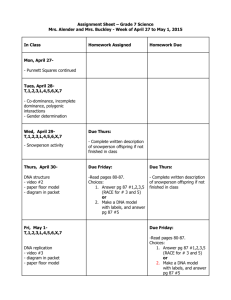Session 2015-2 Spring Mrs. Jessica Call D105 Email: jcall@ben
advertisement
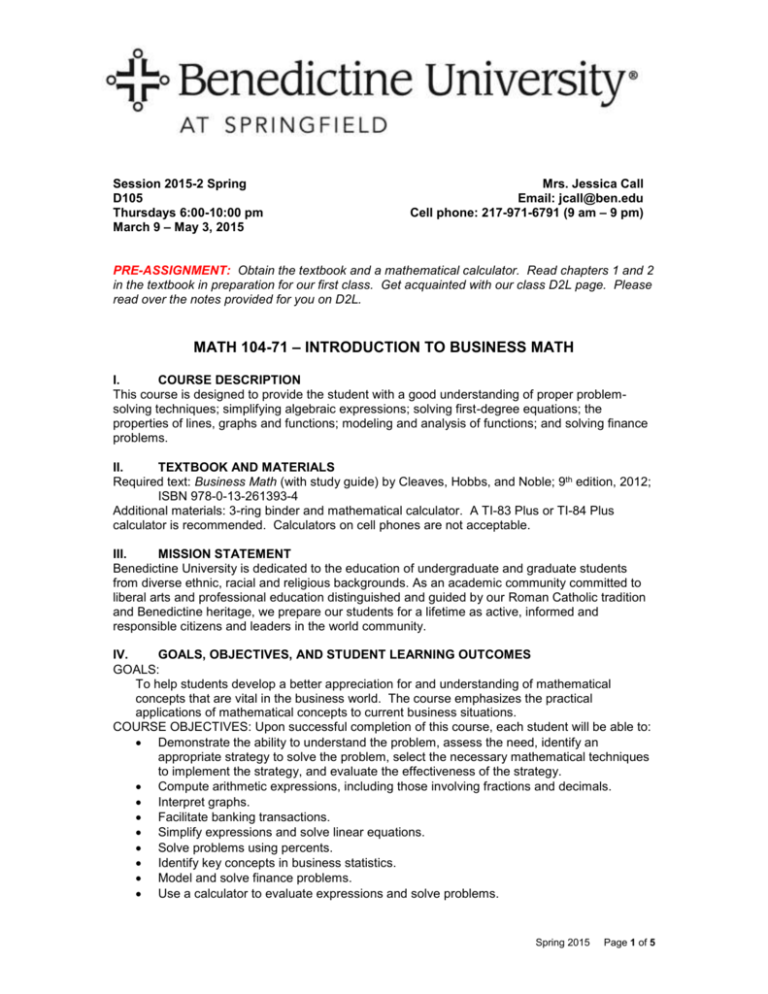
Session 2015-2 Spring D105 Thursdays 6:00-10:00 pm March 9 – May 3, 2015 Mrs. Jessica Call Email: jcall@ben.edu Cell phone: 217-971-6791 (9 am – 9 pm) PRE-ASSIGNMENT: Obtain the textbook and a mathematical calculator. Read chapters 1 and 2 in the textbook in preparation for our first class. Get acquainted with our class D2L page. Please read over the notes provided for you on D2L. MATH 104-71 – INTRODUCTION TO BUSINESS MATH I. COURSE DESCRIPTION This course is designed to provide the student with a good understanding of proper problemsolving techniques; simplifying algebraic expressions; solving first-degree equations; the properties of lines, graphs and functions; modeling and analysis of functions; and solving finance problems. II. TEXTBOOK AND MATERIALS Required text: Business Math (with study guide) by Cleaves, Hobbs, and Noble; 9th edition, 2012; ISBN 978-0-13-261393-4 Additional materials: 3-ring binder and mathematical calculator. A TI-83 Plus or TI-84 Plus calculator is recommended. Calculators on cell phones are not acceptable. III. MISSION STATEMENT Benedictine University is dedicated to the education of undergraduate and graduate students from diverse ethnic, racial and religious backgrounds. As an academic community committed to liberal arts and professional education distinguished and guided by our Roman Catholic tradition and Benedictine heritage, we prepare our students for a lifetime as active, informed and responsible citizens and leaders in the world community. IV. GOALS, OBJECTIVES, AND STUDENT LEARNING OUTCOMES GOALS: To help students develop a better appreciation for and understanding of mathematical concepts that are vital in the business world. The course emphasizes the practical applications of mathematical concepts to current business situations. COURSE OBJECTIVES: Upon successful completion of this course, each student will be able to: Demonstrate the ability to understand the problem, assess the need, identify an appropriate strategy to solve the problem, select the necessary mathematical techniques to implement the strategy, and evaluate the effectiveness of the strategy. Compute arithmetic expressions, including those involving fractions and decimals. Interpret graphs. Facilitate banking transactions. Simplify expressions and solve linear equations. Solve problems using percents. Identify key concepts in business statistics. Model and solve finance problems. Use a calculator to evaluate expressions and solve problems. Spring 2015 Page 1 of 5 V. TEACHING METHODS/DELIVERY SYSTEM This course is a combination of lectures, demonstrations of the problem solving process, and inclass individual/group work. The student is expected to actively participate in all of the methods of delivery. VI. COURSE REQUIREMENTS Attendance Policy This course is highly accelerated, and students will need to take a great deal of responsibility for their own learning outcomes. Attendance is required in each class meeting for the full period of time. Any absence must be due to extraordinary circumstances and will require documentation for it to be considered excused. Documentation must be provided immediately in order to determine what, if any, accommodations are reasonable or possible. Class attendance will directly impact your final grade, and each undocumented absence will be considered unexcused and will result in a 20% reduction in the final grade for the course. Due to the accelerated nature of the course, should you experience a medical condition which prevents you from attending any class(es), appropriate medical documentation must be provided immediately so it may be determined what, if any, accommodations are reasonable or possible. Reading Assignments Students are expected to read the sections of the textbook covered in the Topical Course Outline (section VIII) prior to each class session. Particular attention should be given to the worked out examples of problems provided by the author of the textbook. Be Fully Prepared! Bring your textbook, paper, pencil, calculator, and 3-ring binder to every class. Pens may be used for notes, but all assignments/quizzes/tests must be completed in pencil. Homework should be ready to turn in at the beginning of class. Be prepared to participate in every class session. Homework In order to receive full credit for an assignment, you must complete your assignment neatly and show all of your work. You are not merely graded for correctness, but also on your ability to show how you arrived at your solutions. You are allowed to work together on homework or to seek assistance from a tutor. However, it is not acceptable or tolerated to copy from anyone else or have someone else complete your assignment. As this is an accelerated course with a week between each class session, late assignments will not be accepted. Tests/Final Exam There will be 5 in-class tests during the semester and a comprehensive final exam. Please see the Topical Course Outline (section VIII) for details. Classroom Etiquette Refrain from socializing and any other behaviors that may distract others. Please turn your cell phones off during class! Put them away until class is over. Failure to abide by this rule will result in your dismissal from that class period. Benedictine University at Springfield Student Academic Honesty Policy The search for truth and the dissemination of knowledge are the central missions of a university. Benedictine University at Springfield pursues these missions in an environment guided by our Roman Catholic tradition and our Benedictine heritage. Integrity and honesty are therefore expected of all University students. Actions such as cheating, plagiarism, collusion, fabrication, forgery, falsification, destruction, multiple submission, solicitation, and misrepresentation are violations of these expectations and constitute unacceptable behavior in the University community. Spring 2015 Page 2 of 5 Student’s Responsibility Though there is no formal honor code at Benedictine University at Springfield, students are expected to exhibit academic honesty at all times. Violations against academic honesty are always serious and may result in sanctions that could have profound long-term effects. The final responsibility for understanding the Academic Honesty Policy of the institution, as well as the specific policies for individual courses normally found in syllabi, rests with students. If any doubt exists about what constitutes academic dishonesty, students have the responsibility to talk to the faculty member. Students should expect the members of their class to be academically honest. If students believe one or more members of the class have been deceitful to gain academic advantage in the class, students should feel comfortable to approach the faculty member of the course without prejudice. Violations of the Academic Honesty Policy will be reported to the Office of the Dean of Academic Affairs. Along with a verbal warning, the following are consequences a student may face for academic dishonesty: a failing grade or “zero” for the assignment; dismissal from and a failing grade for the course; or dismissal from the Institution. VII. MEANS OF EVALUATION Five In-Class Tests: 60% Homework, In-class work, participation: 25% Final Exam: 15% 100% Grading Scale: A: 90-100% B: 80-89% C: 70-79% D: 60-69% F: below 60% If a student believes that an error has been made in reporting a grade, an appeal must be made in writing to the instructor and must be initiated within 60 calendar days after the end of the term for which the grade in question was reported. The appeal should contain specific information about why it is believed the grade reported is inaccurate. See the Student Handbook for additional details. Add/Drop Dates Please refer to the current Academic Calendar for add/drop dates. Incomplete Request To qualify for an “I” grade, a minimum of 75% of the course work must be completed with a “C” or better, and a student must submit a completed “Request for an Incomplete” form to the Registrar’s Office. The form must be completed by both student and instructor, but it is the student’s responsibility (not the instructor’s) to initiate this process and obtain the necessary signatures. Student Withdrawal Procedure It is the student’s responsibility to officially withdraw from a course by completing the appropriate form, with appropriate signatures, and returning the completed form to the Advising Office. Please refer to the Student Handbook for important financial information related to withdrawals. Spring 2015 Page 3 of 5 VIII. TOPICAL COURSE OUTLINE It is important that you also refer to the two-week handouts that you will receive in class outlining your assignments. Date Thurs. 3/12 Section 1.1 1.2 Topic of Instruction Chapter 1: Review of Whole Numbers and Integers Place Value and Our Number System Operations with Whole Numbers and Integers 2.1 2.2 2.3 Chapter 2: Review of Fractions Fractions Adding and Subtracting Fractions Multiplying and Dividing Fractions TEST #1 over Chapters 1 & 2 3.1 3.2 3.3 Chapter 3: Decimals Decimals and the Place-Value System Operations with Decimals Decimal and Fraction Conversions 4.1 4.2 Chapter 4: Banking Checking Account Transactions Bank Statements TEST #2 over Chapters 3 & 4 5.1 5.2 5.3 Chapter 5: Equations Equations Using Equations to Solve Problems Formulas 6.1 6.2 6.3 Chapter 6: Percents Percent Equivalents Solving Percentage Problems Increases and Decreases TEST #3 over Chapters 5 & 6 7.1 7.2 7.3 Chapter 7: Business Statistics Graphs and Charts Measures of Central Tendency Measures of Dispersion 8.1 8.2 8.3 Review the first half of course material Chapter 8: Trade and Cash Discounts Single Trade Discounts Trade Discount Series Cash Discounts and Sales Terms Thurs. 3/19 Thurs. 3/26 Thurs. 4/2 Thurs. 4/9 9.1 9.2 9.3 Chapter 9: Markup and Markdown Markup Based on Cost Markup Based on Selling Price and Markup Comparisons Markdown, Series of Markdowns, and Perishables Spring 2015 Page 4 of 5 TEST #4 over Chapters 7, 8, & 9 Thurs. 4/16 10.1 10.2 10.3 Chapter 10: Payroll Gross Pay Payroll Deductions The Employer’s Payroll Taxes 11.1 11.2 11.3 Thurs. 4/23 Chapter 11: Simple Interest and Simple Discount The Simple Interest Formula Ordinary and Exact Interest Promissory Notes TEST #5 over Chapters 10 & 11 Thurs. 4/30 Review for Final Exam FINAL EXAM over Chapters 1-11 IX. AMERICANS WITH DISABILITIES ACT (ADA) Benedictine University at Springfield provides individuals with disabilities reasonable accommodations to participate in educational programs, activities, and services. Students with disabilities requiring accommodations to participate in campus-sponsored programs, activities, and services, or to meet course requirements, should contact the Resource Center as early as possible: springaccess@ben.edu or (217) 717-9253. X. ASSESSMENT Goals, objectives, and learning outcomes that will be assessed in the class are stated in this syllabus. Instructor will use background knowledge probes, one-minute papers, reflective essays and/or other Classroom Assessment Techniques as deemed necessary in order to provide continuous improvement of instruction. Spring 2015 Page 5 of 5
